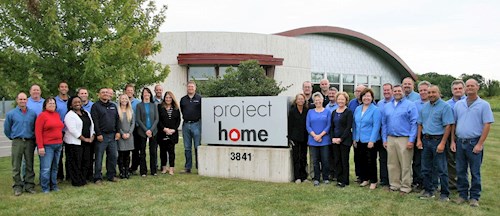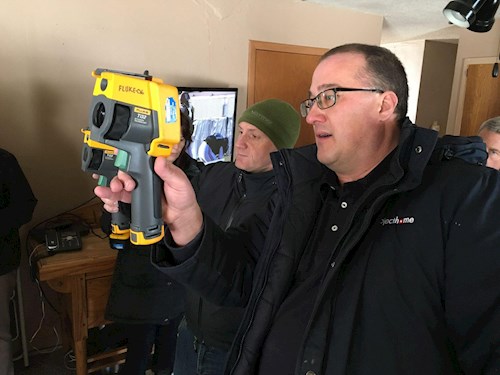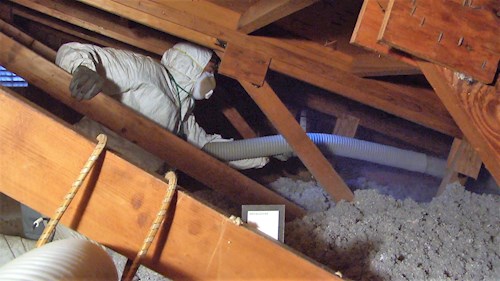
by Heather Phelps

One of the Dane County Office of Energy and Climate Change’s most varied categories for Climate Champions is Catalyst. Catalysts are organizations and advocacy groups that help individuals and businesses choose climate-friendly options.
One such Climate Champion Catalyst is Project Home, a nonprofit that serves low-income families in Dane and Green Counties by helping to weatherize their homes or apartments, and repair or replace non-functioning furnaces.
Project Home began in 1970, with volunteers wanting to improve homes in their own neighborhoods. Early leaders of the group quickly realized the great need in the community, along with the importance for this work to be done by trained staff, and registered as a nonprofit. For more than four decades, Project Home has operated the Weatherization and Furnace Programs for the Wisconsin Department of Administration's Division of Energy, Housing, and Community Resources (DEHCR). These programs offer weatherization and emergency heating assistance to qualifying homeowners and renters at no cost to the occupants. In 2021, beneficiaries of Project Home’s Home Repair Program included 59% senior citizens, 50% disabled homeowners, 64% female head of household, 33% BIPOC community members, and 15% military veterans.
Other Project Home programs include Serving Those Who Served, a privately funded initiative that helps low-to-moderate income military veterans with home repairs, accessibility modifications, and energy efficiency improvements. Project Home’s Optimus division offers paid contracting work to community members, with the profits going back into Project Home’s nonprofit programs.
Jason Hafeman, Project Home’s Outreach Manager, stresses how valuable the weatherization program is for low income families. Even if two households pay exactly the same amount for energy, for low income families that can be a much higher percentage of household expenses. A median income family might pay 3% of their income for energy; a low-income family might pay 14%. Accordingly, “Weatherization makes permanent improvements to bring down a building’s energy usage.” In fact, Jason says, a weatherized home can save $400 every year on energy bills.
Over the 45 years Project Home has weatherized more than 21,000 homes. "Between the Weatherization Program, our Optimus initiative, and our Serving Those Who Served Program, Project Home weatherizes approximately 250 Dane County homes per year, with an average energy reduction of 20%,” Jason says.
How The Process Works
The weatherization process starts by performing an depressurization air test on anywhere from a single-family home up to a 24-unit apartment building. The building is sealed up and a large fan in the front door sucks air out of the building. Crew members can then use infrared cameras to determine where air is able to leak into the house.

Then comes the process of sealing those leaks - usually in ceilings, the attic, basements, and crawl spaces.

Once the leaks are sealed, additional insulation is added to slow heat loss. Safety is a key priority, Jason notes, with crew members swathed head to toe in protective suits with masks and goggles. To protect the crew, it’s also important to plan the work schedule carefully - midday in the middle of summer is not the time to be working in an attic!

Besides the weather, other challenges include the fact that every house is different, and some home designs can make it difficult to access key locations. “Luckily we have a very experienced crew,” Jason says. Project Home is also very conscientious that, “We’re doing work in people’s homes. We want to be communicative with families and make sure people are comfortable.”
Most importantly, though, is that, “Weatherization is a key aspect of energy conservation, which is a big step towards fighting climate change,” Jason says. “We just want to do our part.”
Project Home is a great example of the importance of reducing overall energy use in order to meet climate change goals. The local nonprofit also exemplifies Dane County’s Climate Action Plan’s guiding principle of Equity & Justice, as it focuses on those residents of Dane County who are most in need of lower energy bills but least able to pay for that work themselves.
According to U.S. News & World Report, households with lower incomes, older adults, and communities of color bear the largest burden of energy costs, to a disproportionate degree: “Compared with non-Hispanic white households, Black households spend 43% more of their income on energy costs, Hispanic households spend 20% more and Native American households spend 45% more.” Weatherization “can cut household energy use by about 25%, in turn reducing the greenhouse gas emissions that cause climate change. These upgrades also provide long-term energy affordability for families.”
Even for those not eligible for Project Home’s weatherization program, Project Home offers opportunities for education on energy efficiency with free, public presentations. On their YouTube channel, Project Home shares presentations on home energy, maintenance, and repair. They also have in person home maintenance and improvement classes, which are held throughout the year at numerous local libraries.
In addition, Project Home partners with Madison Water Utility to offer the Home Water Conservation Program, which replaces higher water usage toilets with high-efficiency toilets. In six years, they have helped 500 residents in 200 households reduce their water usage and water bills.
We’re proud to recognize Project Home as a Dane County Climate Champion who is helping families across the county save energy!